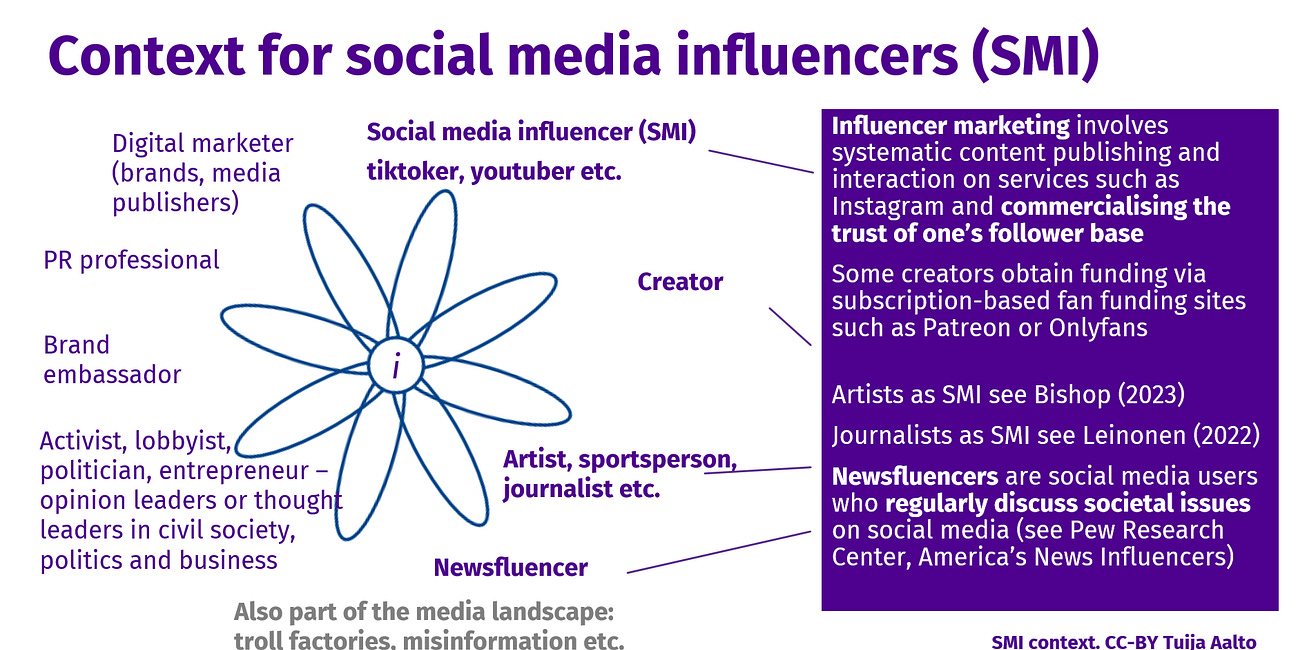What is "Influence Industry" and how does it differ from Influencer Industry?
Scholars: Influence Industry combines traditional communication tactics with new technologies to influence audiences often without their full awareness.
The digital information landscape is evolving rapidly. A group of actors which Emma L. Briant and Vian Bakir (2025) call digital influence mercenaries employ misinformation and manipulation to advance their agendas.
The Routledge Handbook of the Influence Industry (2025) examines the growing ecosystem of actors, technologies, and services shaping public opinion, behavior, or decision-making for political, commercial, or strategic goals, employing unethical tactics such as emotional manipulation.
Core Features of the Digital Influence Industry are
Strategically Coordinated Interconnected Systems
Data-Driven Profiling
Behavior change.
”While coordinated systems, forms of data profiling and behavior change have always existed in the Influence Industry, we would argue that where all three of these features of the digital Influence Industry exist together, manipulation may be more likely” (p. 30)
The Handbook situates Influence Industry research in propaganda studies, informed by various other fields of study from intelligence and surveillance studies to computer science, psychology, business, and management. The principal actors are governments and businesses, often in collaboration.
The Influencer_ Industry
The Influencer Industry associated with social media content producers cultivating their personal brands shares similar roots in study of influence and persuasion.
Emily Hund (2023, 6): defines influencer industry as
a complex ecosystem, comprising influencers and those who aspire to be them, marketers and technologists, brands and sponsors, social media corporations, and a host of others, including talent managers and trend forecasters.
Hund describes the influencer industrial ethos as
the idea that anyone can cultivate a loyal audience by providing consistent and relatable content on social media, and then use that audience’s likes, follows, and other engagement metrics as evidence of “influence” to be leveraged for a range of social and economic rewards (p. 1).
A body of research on individuals pursuing social media -based careers and companies supporting them, including influencer marketing agencies, has accumulated in the fields of advertising, marketing, strategic communications, celebrity studies, media industry studies, and related fields: for instance, Poell et al. (2022) attempted to holistically theorize platformization of cultural production, covering social media influencers and many types of platform intermediaries as some of many actors utilizing platform infrastructures.
The authenticity-inauthenticity axis of platformized influence
Both the Influence Industry and the Influencer Industry are relevant to my research on how platformization is reshaping the media landscape in the small Nordic nation of Finland. Rooted in the study of influence and persuasion, both concepts are now situated within a hybrid media logic (Chadwick 2017). They also highlight the role of platform giants such as Google and Meta, which provide the data infrastructure that enables various forms of influence to be enacted.
The notion of authenticity may serve as a useful lens for demarcating the two: while the Influencer Industry relies on the sustained performance of authenticity (Hund 2023), the Influence Industry operates through more opaque, strategic, and frequently inauthentic mechanisms of persuasion (Briant et al 2025).
See also my earlier post
Influencers and influencer marketing defined, plus context
The media landscape is saturated by people communicating with an agenda. They include personal brands such as social media influencers (SMI) or creators, as well as activists, politicians, business owners and entrepreneurs. Not all of them are part of what we call Influencer industry (Hund 2023) but they are part of today’s hybrid media landscape (Chadw…
References
Bakir, V., & Briant, E. L. (2025). Introducing the digital influence industry. In E. L. Briant, & V. Bakir (Eds.), Routledge Handbook of the Influence Industry (1st ed., pp. 3-16). Routledge. https://doi.org/10.4324/9781003256878-2
Briant, E. L., & Bakir, V. (2025). Concepts for Understanding the Influence Industry. In Routledge Handbook of the Influence Industry (1st ed., pp. 17–34). Routledge. https://doi.org/10.4324/9781003256878-3
Briant, E. L., & Bakir, V. (2025). Conclusion. In Routledge Handbook of the Influence Industry (1st ed., pp. 396–401). Routledge. https://doi.org/10.4324/9781003256878-29
Briant, E.L., et al. Routledge Handbook of the Influence Industry. 1st ed., Routledge, 2025, https://doi.org/10.4324/9781003256878.
Chadwick, A. (2017). The hybrid media system: Politics and power. Oxford University Press.
Hund, E. (2023). The influencer industry: The quest for authenticity on social media. Princeton University Press.
Poell, T., Nieborg, D. B., & Duffy, B. E. (2022). Platforms and cultural production. Polity Press.





